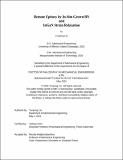Remote Epitaxy by In-Situ Grown BN and InGaN Strain Relaxation
Author(s)
Liu, Yunpeng
DownloadThesis PDF (3.156Mb)
Advisor
Kim, Jeehwan
Terms of use
Metadata
Show full item recordAbstract
Compound semiconductors have superior material properties over silicon, making them good candidates for optoelectronics and power electronics. As the need for electronics with higher flexibility and smaller size increases, lift-off methods for fabricating freestanding compound semiconductors are developed. In 2017, a layer transfer technique based on remote epitaxy was introduced to overcome the drawbacks of conventional lift-off methods. By inserting a layer of 2D material between the epitaxial layer and the substrate, the epitaxial layer can be mechanically peeled off because of the van der Waals gap created. At the same time, the thin 2D layer still allows the penetration of the substrate electrostatic potential, which seeds the single-crystalline growth. However, the complex 2D materials transferring processes generate damage and contamination of the 2D materials. This thesis introduces a novel remote epitaxy process based on MBE in-situ grown boron nitride (BN). Ultrathin (200nm) single-crystalline freestanding gallium nitride (GaN) film is obtained using this technique. A high throughput process is demonstrated to produce multiple freestanding membranes from a single wafer and in a single growth without involving time-consuming processes. Substrate recycling is shown without the need for wafer polishing. To emphasize the uniqueness of the ultrathin single-crystalline GaN membrane, a chip-less wireless e-skin based on surface acoustic wave sensors is reported here. This device offers high sensitivity, lower power and long-term sensing of strain and ultraviolet light. The merits of remote epitaxy are not limited to fabricating freestanding membranes. Previously, remote heteroepitaxy was found to be able to relax the misfit strain caused by lattice mismatch. For example, the large lattice mismatch between the high indium content indium gallium nitride (InGaN) and the GaN substrate impedes the efficiency of the InGaN based red micro-LED. In the last part, relaxed high indium content InGaN film grown on BN is demonstrated. The as-grown film shows a 70 percent relaxation, 28 percent indium content and improved crystalline quality compared with InGaN on GaN heteroepitaxy. We envision this InGaN buffer can be used as the foundation for the InGaN base red LED in the future.
Date issued
2024-05Department
Massachusetts Institute of Technology. Department of Mechanical EngineeringPublisher
Massachusetts Institute of Technology